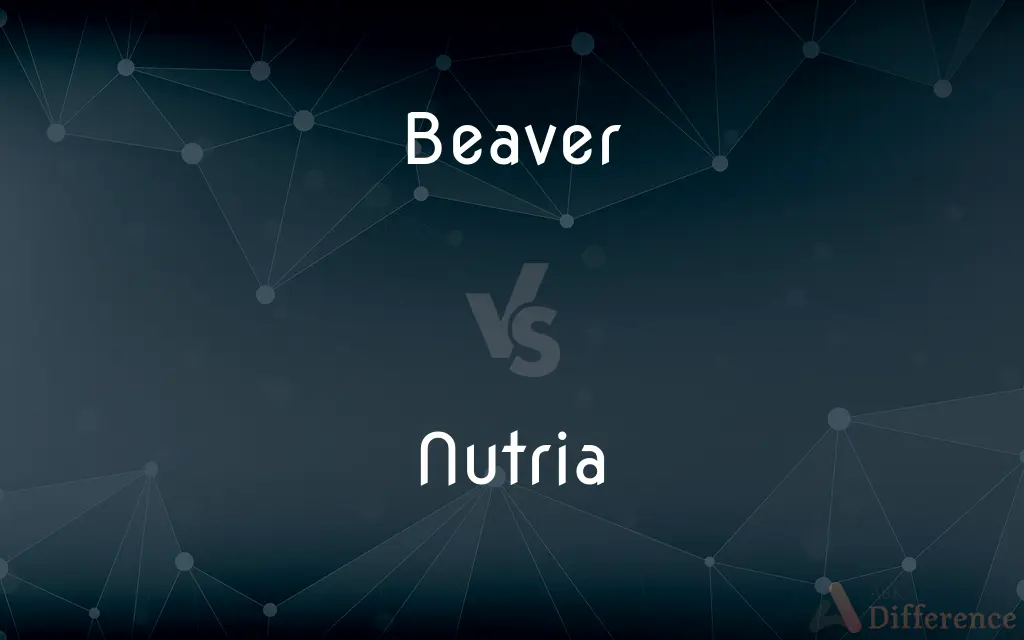Beaver vs. Nutria — What's the Difference?
By Tayyaba Rehman & Fiza Rafique — Updated on March 19, 2024
Beavers are known for their dam-building skills and large, flat tails, while nutrias, also called coypus, are recognized for their rat-like appearance and webbed hind feet.

Difference Between Beaver and Nutria
Table of Contents
ADVERTISEMENT
Key Differences
Beavers are large, semiaquatic rodents famous for their dam-building abilities and distinct large, flat tails that serve various purposes, including aiding in swimming, balancing, and fat storage. On the other hand, nutrias, often mistaken for beavers or large rats, are notable for their smaller size, long, round tails, and orange teeth, which are adaptations for their aquatic lifestyle.
While beavers have a dense underfur and coarse outer guard hairs that keep them warm and dry in cold water, nutrias have a less specialized fur, which makes them more susceptible to cold climates. This fur difference has influenced their geographical spread, with beavers found in colder regions and nutrias in more temperate zones.
Beavers are primarily nocturnal and are known for their complex social structures within family units. They play a significant role in ecosystem engineering by creating wetlands through dam construction. Nutrias, however, are more adaptable in their habits, being active both day and night, and they do not build dams. Their social behavior tends to be less structured compared to beavers.
The diet of a beaver is predominantly woody plant material, especially the soft cambial layer beneath the bark of trees. This contrasts with nutrias, which prefer a diet of aquatic plants and roots, demonstrating a clear distinction in their ecological niches and the impact they have on their environments.
In terms of human interaction, beavers are often valued for their ecological contributions and the fur trade, albeit they can be considered pests when their dam-building activities flood human areas. Nutrias, introduced outside their native South America, have become invasive in many regions, causing significant damage to wetlands and competing with native species for resources.
ADVERTISEMENT
Comparison Chart
Size
Larger, up to 60 lbs
Smaller, up to 20 lbs
Tail
Large, flat, and paddle-shaped
Long, round, and rat-like
Teeth
Large, powerful incisors, not distinctly colored
Large incisors, often orange or reddish
Habitat
Cold freshwater rivers, lakes, and ponds
More temperate, freshwater and brackish environments
Social Structure
Strong family units, complex social behavior
Less structured, can be solitary or in small groups
Diet
Woody plant material, tree bark
Aquatic plants, roots
Human Interaction
Valued for ecological contributions, sometimes considered pests
Often considered invasive, causing environmental damage
Compare with Definitions
Beaver
Semiquatic Rodent
Beavers are known for their impressive ability to build dams and lodges in waterways.
Nutria
Aquatic Rodent
Nutrias, also known as coypus, are often found near water bodies and wetlands.
Beaver
Flat Tail
A beaver's tail serves multiple purposes, including balance, fat storage, and communication.
Nutria
Orange Teeth
Nutrias have distinctive orange teeth due to the iron content in their enamel.
Beaver
Dam Building
The beaver uses its strong teeth to cut down trees for dam construction.
Nutria
Invasive Species
Originally from South America, nutrias have become invasive in many parts of the world.
Beaver
Ecosystem Engineer
By building dams, beavers create wetlands that support diverse ecosystems.
Nutria
Vegetarian Diet
Nutrias feed primarily on aquatic plants and roots, affecting local vegetation.
Beaver
Cold Adapted
Beavers have a dense fur coat and a fat layer to withstand cold water temperatures.
Nutria
Webbed Hind Feet
Nutrias have webbed hind feet that make them excellent swimmers in their aquatic habitats.
Beaver
A hat made of beaver fur or similar material
Nutria
The skin or fur of the coypu.
Beaver
Beavers are large, semiaquatic rodents in the genus Castor native to the temperate Northern Hemisphere. There are two extant species: the North American beaver (Castor canadensis) and the Eurasian beaver (C. fiber).
Nutria
A large semiaquatic rodent (Myocastor coypus) native to South America, having webbed feet and a long tail. It is widely raised for fur and has formed wild populations especially in the southern United States.
Beaver
Either of two large semiaquatic rodents, Castor canadensis of North America or C. fiber of Eurasia, having thick brown fur, webbed hind feet, a broad flat tail, and sharp incisors used for gnawing bark and felling trees, with which they construct dams and underwater lodges.
Nutria
The light brown fur of the nutria. In both senses also called coypu.
Beaver
The fur of a beaver.
Nutria
The coypu, Myocastor coypus.
Beaver
A top hat originally made of the underfur of a beaver.
Nutria
The fur of the coypu.
Beaver
A napped wool fabric, similar to felt, used for outer garments.
Nutria
The fur of the coypu. See Coypu.
Beaver
Vulgar Slang The female genitals.
Nutria
Aquatic South American rodent resembling a small beaver; bred for its fur
Beaver
Offensive Slang A woman or girl.
Beaver
A piece of armor attached to a helmet or breastplate to protect the throat or lower face.
Beaver
The visor on a helmet.
Beaver
Of or relating to a beaver or beavers
Beaver fur.
A beaver hat.
Beaver
Constructed by beavers
Beaver dams.
Beaver
To work diligently and energetically.
Beaver
To spot a beard in a game of beaver.
Beaver
To work hard.
Beaver
To cut a continuous ring around a tree that one is felling.
Beaver
(backgammon) After being doubled, to immediately double the stakes again, a move that keeps the doubling cube on one’s own side of the board.
Beaver
(countable) A semiaquatic rodent of the genus Castor, having a wide, flat tail and webbed feet.
Beaver
The fur of the beaver.
Beaver
(countable) A hat, of various shapes, made from a felted beaver fur (or later of silk), fashionable in Europe between 1550 and 1850.
Beaver
(North American) Beaver pelts as an article of exchange or as a standard of value.
Beaver
Beaver cloth, a heavy felted woollen cloth, used chiefly for making overcoats.
Beaver
A brown colour, like that of a beaver.
Beaver
A move in response to being doubled, in which one immediately doubles the stakes again, keeping the doubling cube on one’s own side of the board.
Beaver
Senseid|en|member of the youngest wing of the Scout movement}} {{alternative case form of Beaver.
Beaver
Senseid|en|part of a helmet}} {{alternative spelling of bevor.
Beaver
An amphibious rodent, of the genus Castor.
Beaver
The fur of the beaver.
Beaver
A hat, formerly made of the fur of the beaver, but now usually of silk.
A brown beaver slouched over his eyes.
Beaver
Beaver cloth, a heavy felted woolen cloth, used chiefly for making overcoats.
Beaver
A man's beard.
Beaver
The hair on a woman's pubic area; - vulgar.
Beaver
A woman; - vulgar and offensive.
Beaver
A person who works enthusiastically and diligently; - used especially in the phrase eager beaver.
Beaver
That piece of armor which protected the lower part of the face, whether forming a part of the helmet or fixed to the breastplate. It was so constructed (with joints or otherwise) that the wearer could raise or lower it to eat and drink.
Beaver
The soft brown fur of the beaver
Beaver
A full beard
Beaver
A man's hat with a tall crown; usually covered with beaver or silk
Beaver
A movable piece of armor on a medieval helmet used to protect the lower face
Beaver
Large semiaquatic rodent with webbed hind feet and a broad flat tail; construct complex dams and underwater lodges
Beaver
Work hard on something
Common Curiosities
What roles do beavers and nutrias play in their ecosystems?
Beavers are ecosystem engineers that create wetlands, while nutrias, often invasive, can damage wetland vegetation and compete with native species.
What is the significance of a beaver's tail?
A beaver's tail serves for balance, communication, fat storage, and aids in swimming.
Why are nutrias considered invasive in many areas?
Nutrias have been introduced outside their native South America, where they cause environmental damage and compete with native species.
How do beavers and nutrias impact human activities?
Beavers can be considered pests due to flooding from dam building, while nutrias damage wetlands and agricultural lands.
What are the primary habitats of beavers and nutrias?
Beavers thrive in cold freshwater environments like rivers and lakes, while nutrias prefer temperate, freshwater, and brackish wetlands.
How do beavers and nutrias differ in appearance?
Beavers are larger with a flat, paddle-shaped tail, while nutrias are smaller with a long, round, rat-like tail.
Why do nutrias have orange teeth?
The orange color of nutria teeth is due to iron in the enamel, which strengthens their teeth against wear.
How do beavers and nutrias respond to cold climates?
Beavers are well-adapted to cold climates with their dense fur and fat, while nutrias are less tolerant of cold and do not thrive in very cold environments.
What kind of diet do beavers and nutrias have?
Beavers consume woody plant material, whereas nutrias eat aquatic plants and roots.
Are beavers and nutrias social animals?
Beavers have complex social structures within family units, while nutrias can be solitary or in small groups with less structured social behavior.
Can beavers and nutrias live in the same environment?
While they may share some habitats, their preferences and impacts on the environment differ significantly.
How do beavers and nutrias adapt to their aquatic lifestyles?
Beavers have a dense fur and fat layer for cold water, while nutrias have webbed hind feet for swimming.
What are the conservation statuses of beavers and nutrias?
Beavers are generally not endangered, but some populations are protected; nutrias are often targeted for eradication due to their invasive status.
How do beavers communicate with each other?
Beavers use vocalizations, scent marking, and tail slapping on water to communicate.
What is the lifespan of a beaver compared to a nutria?
Beavers can live up to 24 years in the wild, whereas nutrias have a shorter lifespan, typically around 6 years.
Share Your Discovery

Previous Comparison
Poem vs. Pom
Next Comparison
Contemptible vs. ContemptuousAuthor Spotlight
Written by
Tayyaba RehmanTayyaba Rehman is a distinguished writer, currently serving as a primary contributor to askdifference.com. As a researcher in semantics and etymology, Tayyaba's passion for the complexity of languages and their distinctions has found a perfect home on the platform. Tayyaba delves into the intricacies of language, distinguishing between commonly confused words and phrases, thereby providing clarity for readers worldwide.
Co-written by
Fiza RafiqueFiza Rafique is a skilled content writer at AskDifference.com, where she meticulously refines and enhances written pieces. Drawing from her vast editorial expertise, Fiza ensures clarity, accuracy, and precision in every article. Passionate about language, she continually seeks to elevate the quality of content for readers worldwide.
















































